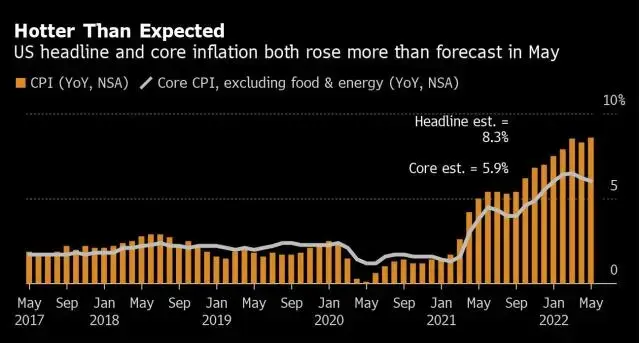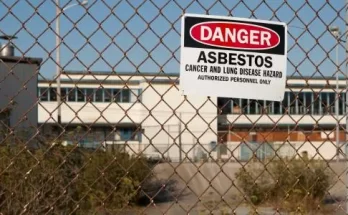In May, US inflation accelerated to a fresh 40-year high. As the news is bad, it will likely push the Federal Reserve to extend an aggressive series of interest-rate hikes, which creates more political problems for the White House and Democrats.
The Consumer Price Index increased 8.6% from a year earlier in a broad-based advance, Labor Department data showed Friday. The inflation rate rose 1% from the month before and beat all estimates. Shelter, food, and gas rose as the largest contributors to the increase.
CPI inflation, which includes the more volatile food and energy components, increased from 0.6% to 6% over this past month and from a year ago.
The inflation numbers dash any hope that inflation had already peaked and was starting to ebb. The gasoline prices paired with unrelenting food and shelter costs are adding strain to Americans’ cost of living, suggesting the Fed will have to pump the brakes on the economy even harder. If a recession does happen, that increase the likelihood of it happening next year.
“There’s little respite from four-decade high inflation until energy and food costs improve and excess demand pressures take a break in response to tighter monetary policy,” Sal Guatieri, senior economist at BMO Capital Markets, said in a note. “The Fed might still raise policy rates ‘just’ 50 bps next week, but it could easily ratchet up the pace beyond then if inflation keeps surging.
The yield on the 10-year Treasury note jumped, stocks opened lower and the dollar rose. Traders price in three increases of 50 basis points by the Federal Reserve over its next three meetings in June, July and September.
Prices for necessities continued to rise at double-digit paces in May. Energy prices climbed 34.6% from the year before, the most since 2005, including a nearly 49% jump in gasoline costs. In June so far, gas prices have risen to new highs, signaling that CPI reports will likely have more upward pressure in coming releases and keeping the Federal Reserve under pressure.
Bloomberg economics says……
“With the next CPI report likely tracking at about the same monthly pace, inflation may not accelerate in the near future. The Fed will likely hike interest rates 50-basis-points more after July, even though the economy is cooling.”
Anna Wong and Andrew Husby are economists.
Grocery prices rose 11.9% annually and electricity increased 12% annually in the past few years. Prices for rent of primary residences also went up 5.2% year-over-year, the fastest climb since 1987.
Huge risks affect the accuracy of price predictions. Russia’s ongoing war in Ukraine, as well as stepped-up related sanctions; potential port disruption due to the upcoming West Coast dockworker contract expiration; Covid-related lockdowns in China and drought could all contribute to higher prices for food and energy.
“Tighter monetary policy will not help much with surging global commodity prices or structural changes in the way people spend and live in the post-pandemic economy,” economists said.
A new poll found that President Joe Biden’s approval ratings have sunk, which could spell trouble for him as Congress holds midterm elections later this year. While the job market remains bright spot, inflation is overshadowing wage gains and people are becoming less confident in their economic situation.
We can see that inflation-adjusted average hourly earnings fell 3% in May from a year earlier. The last time this happened was in April 2021 and the 14th straight decline.
Furniture prices fell in March, it was the first month since October. Overall, demand for goods like apparel and home products pushed up the quarterly GDP to stronger-than-forecast levels.
According to the latest Bloomberg survey, economists had already revised up their estimates for year-over-year inflation through the third quarter of 2023.
Airfares rose 12.6% in May, a slight moderation from the prior month but still up the most on an annual basis since 1980. Prices for hotel stays, meanwhile, were up 22.2% year-over-year. Rising demand for travel and entertainment this summer, particularly among wealthier households who have the savings to support discretionary spending, as well as tight labor market conditions will likely continue.
Consumer spending is holding firm, supported by savings and credit cards. Some economists fear the Fed will go too far in tightening policy, risking weaker spending. Shelter costs — which are the biggest component of the CPI index and make up approx. a third of it — rose 0.6% from April, and 5.5% from last year!
The prices of used cars have been cooling for months, but the rate of price growth increased in May. New vehicle prices increased to 1%.




